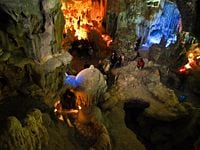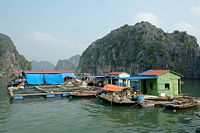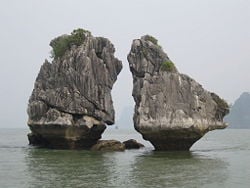Difference between revisions of "Ha Long Bay" - New World Encyclopedia
Dan Davies (talk | contribs) |
Dan Davies (talk | contribs) |
||
| Line 33: | Line 33: | ||
[[Image:Thien Cung.jpg|Thien Cung grotto|thumb|right|200px|Thien Cung grotto]] | [[Image:Thien Cung.jpg|Thien Cung grotto|thumb|right|200px|Thien Cung grotto]] | ||
| − | + | Some 1600 [[limestone]] [[island]]s and inlets, covered by jungle vegetation, populate Halong bay. The effect of some many tightly packed, richly vegetated, islands is remarkable. The islands, for the most part, are uninhabitable, the limestone terrain making living too difficult. | |
| + | |||
| + | Enormous caves exist on some the the islands, giving the sense that the island is hallow.<ref>[http://www.smiletravelvietnam.com/vietnam-travel_Ha-Long_28_travel.aspx Halong Bay, Smile Vietnam Travel.com. Retrieved June 18, 2008.]</ref> Hang Đầu Gỗ (Wooden stakes Cave) is the largest grotto in the Halong area. | ||
| + | |||
| + | French tourists visited in the late 19th century, and named the cave ''Grotte des Merveilles''. Its three large chambers contain large numerous stalactites and stalagmites (as well as 19th century French [[graffiti]]). There are two bigger islands, Tuan Chau and [[Cat ba island|Cat Ba]], that have permanent inhabitants. Both of them have tourist facilities, including hotels and beaches. There are a number of wonderful beaches on the smaller islands. | ||
Some of the islands support floating villages of fishermen, who ply the shallow waters for 200 species of [[fish]] and 450 different kinds of [[mollusk]]s. Many of the islands have acquired their names as a result of interpretation of their unusual shapes: such names include Voi Islet (elephant), Ga Choi Islet (fighting cock), and Mai Nha Islet (roof). 989 of the islands have been given names. Birds and animals including [[bantam]]s, [[antelope]]s, [[monkey]]s, and [[iguana]]s also live on some of the islands. | Some of the islands support floating villages of fishermen, who ply the shallow waters for 200 species of [[fish]] and 450 different kinds of [[mollusk]]s. Many of the islands have acquired their names as a result of interpretation of their unusual shapes: such names include Voi Islet (elephant), Ga Choi Islet (fighting cock), and Mai Nha Islet (roof). 989 of the islands have been given names. Birds and animals including [[bantam]]s, [[antelope]]s, [[monkey]]s, and [[iguana]]s also live on some of the islands. | ||
[[Image:FishingVillage HaLongBay Vietnam (pixinn.net).jpg|Floating fishing village|thumb|right|200px]] | [[Image:FishingVillage HaLongBay Vietnam (pixinn.net).jpg|Floating fishing village|thumb|right|200px]] | ||
| − | |||
== Honorable name == | == Honorable name == | ||
Revision as of 21:00, 18 June 2008
| Hạ Long Bay* | |
|---|---|
| UNESCO World Heritage Site | |
Hạ Long bay | |
| Type | Natural |
| Criteria | vii, viii |
| Reference | 672bis |
| Region** | Southeast Asia |
| Inscription history | |
| Inscription | 1994, 2000 (18th, 24th Session) |
| * Name as inscribed on World Heritage List. ** Region as classified by UNESCO. | |
Ha Long Bay (Vietnamese: Vịnh Hạ Long) situates in Quảng Ninh province in northeastern Vietnam, from E106°56' to E107°37' and from N20°43' to N21°09'. The bay stretches from Yên Hưng district, past Hạ Long city, Cẩm Phả town to Vân Đồn district, bordered on the south and southeast by the Gulf of Tonkin, on the north by China and on the west and southwest by Cát Bà island. The bay has a 120 kilometre long coastline and covers approximately 1,553 square kilometres with 1969 islets. UNESCO designated Ha Long Bay a World Heritage site in 1994 and 2000.
The area designated by UNESCO as the World Natural Heritage Site includes 434 km² with 775 islets, the zone defined by Đầu Gỗ island on the west, Ba Hầm lake on the south and Cống Tây island on the east. The protected area extends from the Cái Dăm petrol store to Quang Hanh commune, Cẩm Phả town and the surrounding giants zone. The bay features thousands of limestone karsts and isles in various sizes and shapes.
Origin Myth
Local legend relates that when the Vietnamese fought invading Chinese armies, the gods sent a family of dragons to help defend the land. That family of dragons began spitting out jewels and jade. Those jewels turned into the islands and islets dotting the bay, linking together to form a great wall against the invaders. The people kept their land safe and formed what later became the country of Vietnam. After that, dragons decided to live in Ha Long Bay. The place where Mother Dragon flew down became Hạ Long, the place where the dragon children attended upon their mother received the name Bái Tử Long island (Bái: attend upon, Tử: children, Long: dragon), and the place where the dragon children wriggled their tails violently became known as Bạch Long Vỹ island (Bạch: white- color of the foam made when Children Dragon wriggle, Long: dragon, Vỹ: tail).
History
Mê Cung and Thiên Long archaeological sites in Hạ Long and Bái Tử Long provide a look into Halong Bay's prehistoric period. Mounds of the remains of mountain shellfishes (Cyclophorus) and spring shellfishes (Melania), some fresh water mollusk and some rudimentary labor tools have been found in the site. The Soi Nhụ tribe inhabited the region before 5000 B.C.E. They lived primarily by catching shellfish and fish, collecting fruits and digging for bulbs and roots. Their way of life compares to other tribes in Vietnam during that period, including the Hoà Bình and Bắc Sơn. The Cái Bèo tribe (5000- 3000 B.C.E.), located in Hạ Long and Cát Bà island, developed fishing techniques that including using boats..
Halong Bay has been the setting for battles against invading navies. In the labyrinth of channels in Bach Dang river near the islands, the Vietnamese army stopped the Chinese from landing on three occasions. In 1288, General Tran Hung Dao stopped Mongol ships from sailing up the Bach Dang River by placing steel-tipped wooden stakes at high tide, sinking the Mongol fleet.[1] During the Vietnam War, the United States navy heavily mined many of the channels between the islands, some still pose a threat to shipping.[2]
A community of around 1600 people live on Halong bay in four fishing villages: Cửa Vạn, Ba Hang, Cống Tàu and Vông Viêng in Hùng Thắng commune, Hạ Long city. They live on floating houses, sustained by fishing and marine aquaculture (cultivating marine biota).
System of isles and caves
Some 1600 limestone islands and inlets, covered by jungle vegetation, populate Halong bay. The effect of some many tightly packed, richly vegetated, islands is remarkable. The islands, for the most part, are uninhabitable, the limestone terrain making living too difficult.
Enormous caves exist on some the the islands, giving the sense that the island is hallow.[3] Hang Đầu Gỗ (Wooden stakes Cave) is the largest grotto in the Halong area.
French tourists visited in the late 19th century, and named the cave Grotte des Merveilles. Its three large chambers contain large numerous stalactites and stalagmites (as well as 19th century French graffiti). There are two bigger islands, Tuan Chau and Cat Ba, that have permanent inhabitants. Both of them have tourist facilities, including hotels and beaches. There are a number of wonderful beaches on the smaller islands.
Some of the islands support floating villages of fishermen, who ply the shallow waters for 200 species of fish and 450 different kinds of mollusks. Many of the islands have acquired their names as a result of interpretation of their unusual shapes: such names include Voi Islet (elephant), Ga Choi Islet (fighting cock), and Mai Nha Islet (roof). 989 of the islands have been given names. Birds and animals including bantams, antelopes, monkeys, and iguanas also live on some of the islands.
Honorable name
In 1962, Vietnam Ministry of Culture, Sport and Tourism arranged Halong Bay as National Renowned Lanscape Vestige.
The bay was World's Natural Heritage listed by UNESCO at the 18th meeting of the Committee of the World Heritages of UNESCO (in Phuket, Thailand on December 17th, 1994) for its outstanding universal aesthetic value according to the criteria explained in the Operational Guidelines for the Implementation of the World Heritage Convention. On December 2nd, 2000 at the 24th meeting of Committee of the World Heritages in Cairns, Australia, Halong bay was admitted as a World Heritage Site for its outstanding geological and geomorphological value according to the criteria of that Convention.[4]
Halong bay was introduced to nominate by New Open World Foundation as World's 7 Natural Wonder having result on 08/08/2008.[1]
Geology and geomorphology
History of tectonics
Scientists say that Halong bay has experienced at least 500 million years in the various geological states of orogeny, marine transgression and marine regression. During the Ordovician and Silurian periods (500-410 million years ago), Halong bay was deep sea. During the Carboniferous and Permian periods (340-250 million years ago), Halong Bay was at shallow sea level.
Karst geomorphology value
As of simultaneous combination of factors like thick limestone layer, hot and moist climate and slow tectonic process in whole, Ha Long bay has had a complete karst evolutionary for 20 million years. There are many of karst topography kind in Ha Long such as karst field.
Biodiversity
Ha Long Bay is host to two ecosystems: a tropical, moist, evergreen rainforest ecosystem and a marine & coastal ecosystem. The bay is home to seven endemic species.
Climate
The bay is a sea islands in tropical wet with 2 seasons: hot and moist summer, dry and cold winter. Average temperature is from 15°C- 25°C. Annual rainfall is between 2000mm and 2200mm. Halong bay has the typical diurnal tide system (tide amplitude ranges from 3.5-4m). The salinity is from 31 to 34.5MT in dry season and lower in rainy season.
Endemic species
- Livistona halongensis
- Impatiens halongensis
- Chirieta halongensis
- Chirieta hiepii
- Chirieta modesta
- Paraboea halongensis
- Alpinia calcicola
The many islands that dot the bay are home to a great many other species, including (but likely not limited to): 477 magnoliales, 12 pteris, 20 salt marsh flora and 4 amphibia, 10 reptilia, 40 aves, and 4 mammalia.
Economy
Tourism
Ha Long Bay is perhaps the most popular travel destination of the country. Foreigners and natives alike are attracted to its natural, universal appeal, not to mention the shopping and dining prospects located close by.
Cuisine
Seafood in Ha Long is diversifying. Cuttle-fish- mực, oyester- hà, cyclinae- ngán, prawn (penaeidea- tôm he, panulirus- tôm hùm, parapenaeopsis- tôm sắt...), spunculoideas- sá sùng, nerita- ốc đĩa, charonia tritonis- ốc tù và, cà sáy... are popular in many famous delicious dishes.
In literature
Nguyễn Trãi wrote about Halong bay: "This wonder is ground raises up in the middle of the high sky." Xuân Diệu utter a praise: "Here is the unfinished works of the Beings...Here is the stones which the Giant played and threw away." Nguyên Ngọc summarized: "...to form this first- rate wonder, nature only uses: Stone and Water...There is just only two materials themselves chosen from as much as materials, in order to write, to draw, to sculpture, to create everything...It is quite possible that here is the image of the future world." Ho Chi Minh remarks: "It is the wonder that one cannot impart to others." Pham Van Dong embarrassed: "Is it one scenery or many seceneries? Is it the scenery in the world or somewhere?." Nguyễn Tuân recognized that:"Only mountains accept to be old, but Ha Long sea and wave is young for ever."
Che Lan Vien sensed:
"Hạ Long, Bái Tử Long- Dragons were hidden, only stones still remain
On the moonlight night, stones meditate as men..."
Lord Trịnh Cương overflowed with emotion: "Mountains are glistend by water shadow, water spill all over the sky."
Huy Cận was agitated: "Night breathes, stars wave Ha Long's water."
In popular culture
- It was the theme of Robocon (Asian Pacific Robot Contest) hold in Vietnam in 2007: "Discover Halong" [2]
- The band dredg wrote a song titled Ha Long Bay.
- In the 1997 James Bond film Tomorrow Never Dies, James and Wai Lin attempt to chase down Elliot Carver played by Jonathan Pryce in the Ha Long Bay area.
- It was featured on the Amazing Race 10 on "Leg 4," which was originally aired on October 8, 2006.
- It was featured in the programme The Hairy Bikers' Cookbook.
Gallery
- Vacation Photo 022503.jpg
Ha Long Bay, February 2003
- Halong4.jpg
Ha Long Bay, December 22, 2005
- Halong2.jpg
Boats in Ha Long Bay, December 22, 2005
- Halong18.jpg
Ha Long Bay
See also
- Ha Long
Notes
- ↑ Halong Bay. Retrieved June 18, 2008.
- ↑ Halong Bay History, Trip Advisor.com
- ↑ Halong Bay, Smile Vietnam Travel.com. Retrieved June 18, 2008.
- ↑ Halong Bay - UNESCO World Heritage Site. UNESCO World Heritage Center. Retrieved 2008-06-18.
ReferencesISBN links support NWE through referral fees
- Bowermaster, Jon. 2008. Descending the dragon: my adventures along the coast of Vietnam. Washington, DC: National Geographic Society. ISBN 9781426203046.
- Dõ̂ Phương Quỳnh. 1994. Ha Long Bay and Quang Ninh Province: the face of Vietnam. Hanoi: GIOI. OCLC 221981510.
- Downs, Tom. 2007. Hanoi & Halong Bay. Footscray, Vic: Lonely Planet. ISBN 9781741790924.
- Hill, L., and B. Wald. 1997. "Scaling the Dragon's Spires: Drawn by natural arches and sheer cliffs, sport climbers tackle the Ha Long Bay islands of Vietnam". NATIONAL GEOGRAPHIC. 192 (6): 110-119. OCLC 202484645.
External links
- Halong Bay Information. Retrieved June 18, 2008.
- Halong Bay pictures. Retrieved June 18, 2008.
- Halong Bay - UNESCO World Heritage Site. UNESCO World Heritage Center. Retrieved June 18, 2008.
- Ha Long: Bay of the Descending Dragon, Vietscape.com. Retrieved June 18, 2008.
- Halong Bay, Pictures by QT Luong. terragalleria.com. Retrieved June 18, 2008.
- Halong Bay, Vietnam Tourism.com. Retrieved June 18, 2008.
| ||||||||||
Credits
New World Encyclopedia writers and editors rewrote and completed the Wikipedia article in accordance with New World Encyclopedia standards. This article abides by terms of the Creative Commons CC-by-sa 3.0 License (CC-by-sa), which may be used and disseminated with proper attribution. Credit is due under the terms of this license that can reference both the New World Encyclopedia contributors and the selfless volunteer contributors of the Wikimedia Foundation. To cite this article click here for a list of acceptable citing formats.The history of earlier contributions by wikipedians is accessible to researchers here:
The history of this article since it was imported to New World Encyclopedia:
Note: Some restrictions may apply to use of individual images which are separately licensed.







